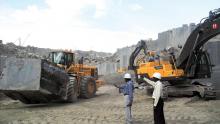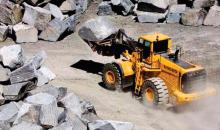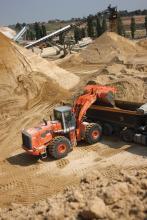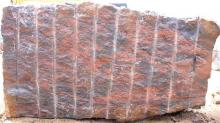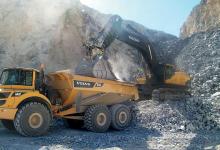Machines from Volvo CE have helped restart production at a quarry in the US state of Colorado. The site had closed down nearly 50 years ago as its remote location meant that margins were slim for the producer.
However, introducing new, modern machines has helped ensure that the site is once more producing the high-quality Yule marble. A leading stone producer in Italy, Carrarabased RED Graniti opted to take over ownership of the Colorado Yule marble quarry in 2011. With a resurgence in demand for the Yule
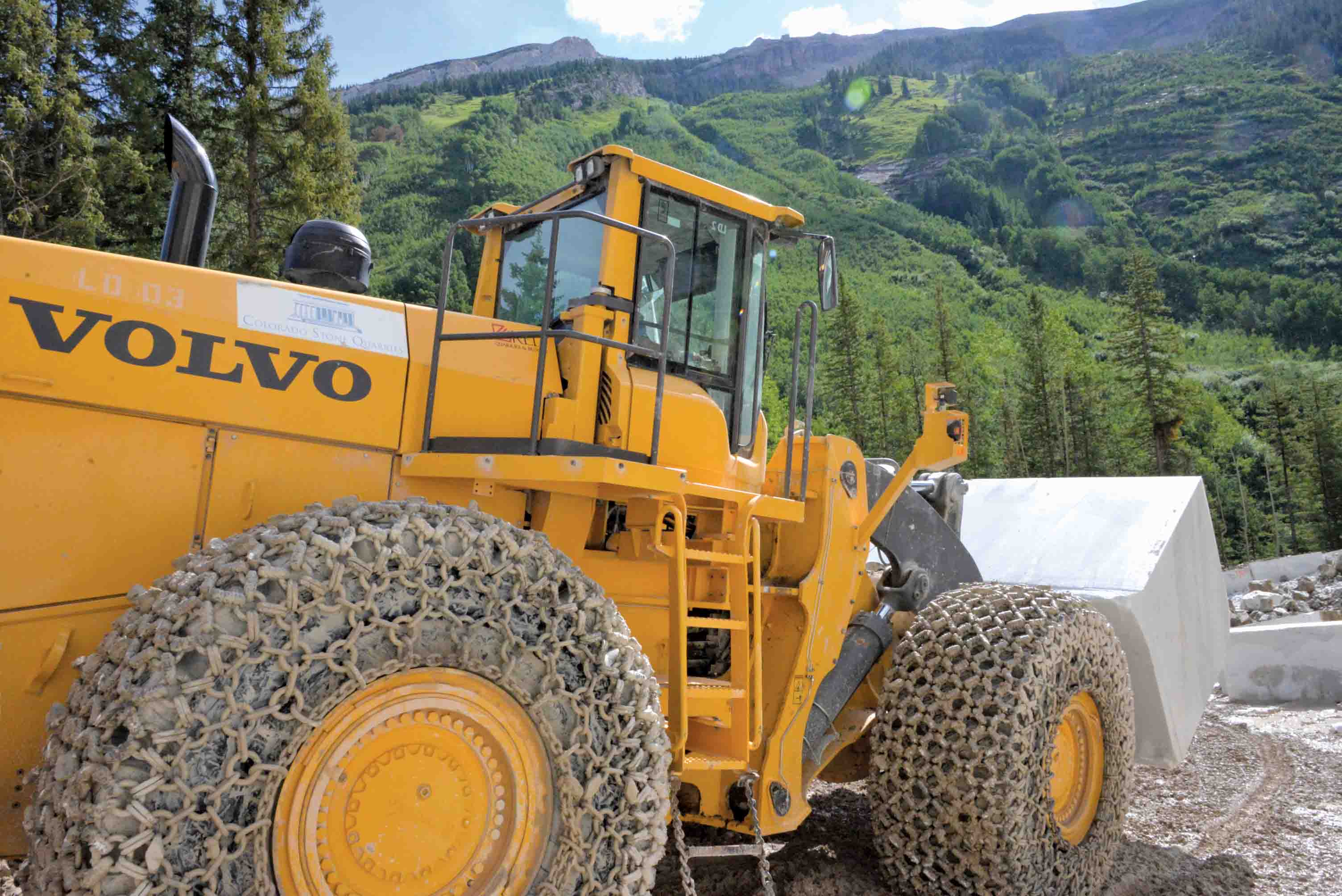
Volvo CE wheeled loaders are used for block handling works at the quarry
Machines from 359 Volvo CE have helped restart production at a quarry in the US state of Colorado. The site had closed down nearly 50 years ago as its remote location meant that margins were slim for the producer.
However, introducing new, modern machines has helped ensure that the site is once more producing the high-quality Yule marble. A leading stone producer in Italy, Carrarabased RED Graniti opted to take over ownership of the Colorado Yule marble quarry in 2011. With a resurgence in demand for the Yule marble, the quarry has now geared up its output. Located in Marble, Colorado, the facility is operating under the name of Colorado Stone Quarries. RED Graniti now holds all mineral rights to a 26ha section of land, known as Treasure Mountain, rich in high-quality marble.
During the assessment of the quarry, the firm located a new vein of stone. To access this new source of stone, the Lincoln Gallery was unearthed, named after the Lincoln Memorial. And this new vein, Calacatta Lincoln, is now the top-selling stone worldwide for RED Graniti. The firm estimates that it has around 1.5 million m3 of marble remaining at the site. To meet the growing demand for the product, Colorado Stone Quarries employs a crew of 40 in its year-round operations. Because the stone is extracted with precision cuts, rather than blasting, the company relies on a fleet of 30 machines that includes Volvo L350F, L330E, L120E and L90E wheeled loaders, an ECR58D compact short swing radius excavator, EC340D and EC480D crawler excavators and an A35D articulated hauler.
Inside the Lincoln Gallery, crews work on two levels. On the lower level, after the initial cuts are made, a Volvo EC340D or EC480D excavator slides into place and uses its bucket teeth to loosen the stones, gently placing them onto the gallery floor for the L350F wheeled loader to load out. Once the large blocks are removed, a Volvo L90E wheeled loader with pallet forks repositions the saw for the next round of cuts. On the second level, the marble blocks are skilfully sliced from the rock face and extracted using the block forks on the L350F.
The two Volvo L350F wheeled loaders are the mine’s workhorses, clocking up 10 hours a day. Fitted with standard duty block handler kit and forks, the machines can carry up to 29.5tonnes. The standard Volvo block handler kit boosts capacity for lifting and withstands the rugged conditions of block handling. Because these loaders use the same linkage systems as standard machines, they can also exchange tools and be used as bucket handlers to load trucks.
Colorado Stone Quarries replaced its entire fleet of equipment when it purchased the site. When the operations management reviewed bids, bottom line price was not the only factor taken into consideration. Total cost of ownership and dealer support influenced the decision to buy the machines, due to the heavy-duty cycling work of the loaders and the remote location. And good fuel economy was another important factor in the decision to opt for these wheeled loaders. Two Power Equipment Company service technicians carry out preventive and routine maintenance on the Volvo units and other equipment, including the stone saws.
Once the marble blocks are selected and carved from the face, they are washed and trimmed to size. Each block is inspected and approved, then loaded onto flatbed semi-trailer trucks and hauled to a logistics stockyard in Delta, Colorado. From there, the majority are sent by rail to Norfolk, Virginia and transferred to containers ready for shipping to Italy. When the stone arrives in Carrara, it is sold to companies specialising in the supply of cut-to-size material for projects all over the world.
In addition to Calacatta Lincoln, Treasure Mountain also yields Statuario Colorado and Calacatta Golden. A perfect example of Calacatta Lincoln is described as bold white with with brown and grey veining and slight brownish fading of the surrounding veins.
However, introducing new, modern machines has helped ensure that the site is once more producing the high-quality Yule marble. A leading stone producer in Italy, Carrarabased RED Graniti opted to take over ownership of the Colorado Yule marble quarry in 2011. With a resurgence in demand for the Yule marble, the quarry has now geared up its output. Located in Marble, Colorado, the facility is operating under the name of Colorado Stone Quarries. RED Graniti now holds all mineral rights to a 26ha section of land, known as Treasure Mountain, rich in high-quality marble.
During the assessment of the quarry, the firm located a new vein of stone. To access this new source of stone, the Lincoln Gallery was unearthed, named after the Lincoln Memorial. And this new vein, Calacatta Lincoln, is now the top-selling stone worldwide for RED Graniti. The firm estimates that it has around 1.5 million m3 of marble remaining at the site. To meet the growing demand for the product, Colorado Stone Quarries employs a crew of 40 in its year-round operations. Because the stone is extracted with precision cuts, rather than blasting, the company relies on a fleet of 30 machines that includes Volvo L350F, L330E, L120E and L90E wheeled loaders, an ECR58D compact short swing radius excavator, EC340D and EC480D crawler excavators and an A35D articulated hauler.
Inside the Lincoln Gallery, crews work on two levels. On the lower level, after the initial cuts are made, a Volvo EC340D or EC480D excavator slides into place and uses its bucket teeth to loosen the stones, gently placing them onto the gallery floor for the L350F wheeled loader to load out. Once the large blocks are removed, a Volvo L90E wheeled loader with pallet forks repositions the saw for the next round of cuts. On the second level, the marble blocks are skilfully sliced from the rock face and extracted using the block forks on the L350F.
The two Volvo L350F wheeled loaders are the mine’s workhorses, clocking up 10 hours a day. Fitted with standard duty block handler kit and forks, the machines can carry up to 29.5tonnes. The standard Volvo block handler kit boosts capacity for lifting and withstands the rugged conditions of block handling. Because these loaders use the same linkage systems as standard machines, they can also exchange tools and be used as bucket handlers to load trucks.
Colorado Stone Quarries replaced its entire fleet of equipment when it purchased the site. When the operations management reviewed bids, bottom line price was not the only factor taken into consideration. Total cost of ownership and dealer support influenced the decision to buy the machines, due to the heavy-duty cycling work of the loaders and the remote location. And good fuel economy was another important factor in the decision to opt for these wheeled loaders. Two Power Equipment Company service technicians carry out preventive and routine maintenance on the Volvo units and other equipment, including the stone saws.
Once the marble blocks are selected and carved from the face, they are washed and trimmed to size. Each block is inspected and approved, then loaded onto flatbed semi-trailer trucks and hauled to a logistics stockyard in Delta, Colorado. From there, the majority are sent by rail to Norfolk, Virginia and transferred to containers ready for shipping to Italy. When the stone arrives in Carrara, it is sold to companies specialising in the supply of cut-to-size material for projects all over the world.
In addition to Calacatta Lincoln, Treasure Mountain also yields Statuario Colorado and Calacatta Golden. A perfect example of Calacatta Lincoln is described as bold white with with brown and grey veining and slight brownish fading of the surrounding veins.

